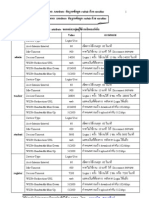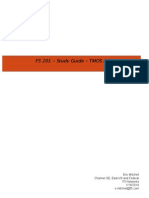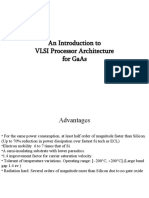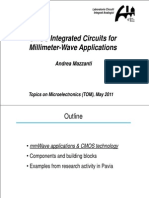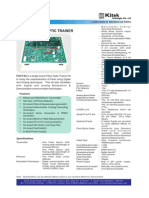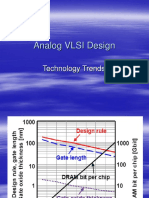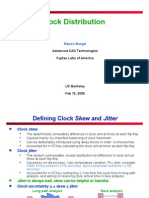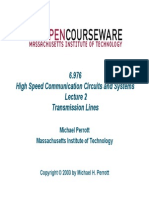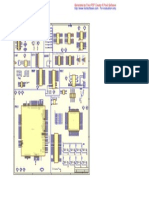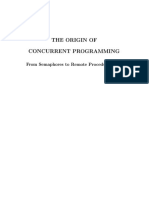Lec1 Overview
Lec1 Overview
Uploaded by
gariyakCopyright:
Available Formats
Lec1 Overview
Lec1 Overview
Uploaded by
gariyakCopyright
Available Formats
Share this document
Did you find this document useful?
Is this content inappropriate?
Copyright:
Available Formats
Lec1 Overview
Lec1 Overview
Uploaded by
gariyakCopyright:
Available Formats
6.
976
High Speed Communication Circuits and Systems
Lecture 1
Overview of Course
Michael Perrott
Massachusetts Institute of Technology
Copyright 2003 by Michael H. Perrott
M.H. Perrott MIT OCW
Wireless Systems
Direct conversion architecture
sin(w
o
t)
90
o
D/A
D/A
Digital
Processing
Block
Digital
Processing
Block
sin(w
o
t)
90
o
A/D
A/D
Transmit IC Receive IC
LNA
Power
Amp
Transmitter issues
- Meeting the spectral mask (LO phase noise & feedthrough,
quadrature accuracy), D/A accuracy, power amp linearity
Receiver Issues
- Meeting SNR (Noise figure, blocking performance, channel
selectivity, LO phase noise, A/D nonlinearity and noise),
selectivity (filtering), and emission requirements
M.H. Perrott MIT OCW
Future Goals
Low cost, low power, and small area solutions
- New architectures and circuits!
Increased spectral efficiency
- Example: GSM cellphones (GMSK) to 8-PSK (Edge)
Requires a linear power amplifier!
Increased data rates
- Example: 802.11b (11 Mb/s) to 802.11a (> 50 Mb/s)
GFSK modulation changes to OFDM modulation
Higher carrier frequencies
- 802.11b (2.5 GHz) to 802.11a (5 GHz) to ? (60 GHz)
New modulation formats
- GMSK, CDMA, OFDM, pulse position modulation
New application areas
M.H. Perrott MIT OCW
High Speed Data Links
A common architecture
DEMUX
Digital
Processing
Block
Receive IC
Amp
Clock
and Data
Recovery
Clock
Distribution
10 Gb/s
Data Link
MUX Driver
Digital
Processing
Block
Transmit IC
Clock Generation
Transmitter Issues
- Intersymbol interference (limited bandwidth of IC
amplifiers, packaging), clock jitter, power, area
Receiver Issue
- Intersymbol interference (same as above), jitter from
clock and data recovery, power, area
M.H. Perrott MIT OCW
Future Goals
Low cost, low power, small area solutions
- New architectures and circuits!
Increased data rates
- 40 Gb/s for optical (moving to 120 Gb/s!)
Electronics is a limitation (optical issues getting significant)
- > 5 Gb/s for backplane applications
The channel (i.e., the PC board trace) is the limitation
High frequency compensation/equalization
- Higher data rates, lower bit error rates (BER), improved
robustness in the face of varying conditions
- How do you do this at GHz speeds?
Multi-level modulation
- Better spectral efficiency (more bits in given bandwidth)
M.H. Perrott MIT OCW
This Class
Circuit AND system focus
- Knowing circuit design is not enough
- Knowing system theory is not enough
Circuit stuff
- RF issues: transmission lines and impedance transformers
- High speed design techniques
- Basic building blocks: amplifiers, mixers, VCOs, digital
components
- Nonidealities: noise and nonlinearity
System stuff
- Macromodeling and simulation
- Wireless and high speed data link principles
- System level blocks: PLLs, CDRs, transceivers
M.H. Perrott MIT OCW
The Goal Design at Circuit/System Level
1. Design architecture with analytical models
May require new circuits guess what they look like
2. Verify architectural ideas by simulating with ideal
macro-models of circuit blocks
Guess macro-models for new circuits
3. Add known non-idealities of circuit blocks
(nonlinearity, noise, offsets, etc.)
Go back to 1. if the architecture breaks!
4. Design circuit blocks and get better macro-models
Go back to 1. if you cant build the circuit!
Go back to 1. if the architecture breaks!
5. Verify as much of system as possible with SPICE
6. Layout, extract, verify
Do this soon for high speed systems - iteration likely!
M.H. Perrott MIT OCW
Key System Level Simulation Needs
You need a fast simulator
- To design new things well, you must be able to iterate
- The faster the simulation, the faster you can iterate
You need to be able to add non-idealities in a
controlled manner
- Fundamental issues with architectures need to be
separated from implementation issues
An architecture that is fundamentally flawed should be
quickly abandoned
You need flexibility
- Capable of implementing circuit blocks such as filters,
VCOs, etc.
- Capable of implementing algorithms
- Arbitrary level of detail
M.H. Perrott MIT OCW
A Custom C++ Simulator Will Be Used - CppSim
Blocks are implemented with C/C++ code
- High computation speed
- Complex block descriptions
Users enter designs in graphical form using Cadence
schematic capture
- System analysis and transistor level analysis in the
same CAD framework
Resulting signals are viewed in Matlab
- Powerful post-processing and viewing capability
Note: Hspice used for circuit level simulations
CppSim is on Athena and freely downloadable at
http://www-mtl.mit.edu/~perrott
A Quick Preview of Homeworks and Projects
M.H. Perrott MIT OCW
HW1 Transmission Lines and Transformers
High speed data link application:
V
out
C
1
R
L
L
1
Delay = x
Characteristic Impedance = R
o
Ideal Transmission Line
R
o
V
in
Two-Port Model
C
2
E
i1
E
r1
E
i2
E
r2
die
Adjoining pins
Connector
Controlled Impedance
PCB trace
package
On-Chip
Driving
Source
High Speed Trace (RF Connector to Chip Die)
M.H. Perrott MIT OCW
HW2 High Speed Amplifiers
M
4
M
1
M
2
M
3
I
bias
V
in+
R
1
V
in-
R
2
V
o+
V
o-
50
V
in
M
1
M
2
L
s
L
d
L
g
C
big
I
bias
= 1mA
M
3
V
out
C
L
=1pF
5 k
Z
in
x
Broadband
Narrowband
M.H. Perrott MIT OCW
HW3 Amplifier Noise and Nonlinearity
Amplifier circuit
Model
M
1
I
bias
V
out
10
0.18
2
0.18
M
2
R
L
V
in
C
big2
C
big1
R
T
50
V
in
50
50
Nonlinearity
V
out
V
out
= c
o
+ c
1
x + c
2
x
2
+ c
3
x
3
Noise
M.H. Perrott MIT OCW
HW4 Low Noise Amplifiers and Mixers
Narrowband LNA
Passive Mixer
V
in
C
L
R
L
/2 R
L
/2
R
S
/2 C
big
R
S
/2 C
big
LO
LO
LO
LO
V
out
V
out
0 V
0
V
dd
0
V
dd
50
V
in
M
1
M
2
L
s
L
g
C
big
I
bias
= 1mA
M
3
V
out
C
L
=1pF
5 k
Z
in
R
ps
R
pg
R
ps
C
big
L
d
R
pd
M.H. Perrott MIT OCW
HW5 Voltage Controlled Oscillators
Differential CMOS
Colpitts
V
bias
=1.2V
M
1
L
d
=4nH
V
out
C
1
=2pF
I
bias
=100 A
C
2
=8pF
R
d
=10k
M
1
M
2
M
3
V
out
C
tune
3 nH
100/0.18
50/0.18
M
4
100/0.18
50/0.18
V
out
V
in
1.8 V
0 V
M.H. Perrott MIT OCW
Project 1 - High Speed Frequency Dividers
High speed
latches/registers
High speed dual-modulus
divider
L
o
a
d
L
o
a
d
IN IN
OUT OUT
2
2/3
Core
Control
Qualifier
CON
IN OUT
2
A B
2/3
IN
A
B
OUT
CON
*
8 + CON Cycles
CON
*
CON
M.H. Perrott MIT OCW
HW6 Phase Locked Loop Design
Integer-N synthesizer
Phase noise simulation
PFD
Loop
Filter
ref(t) out(t)
Divider
T
T
e(t) vin(t)
div(t)
VCO
N[k] = N
nom
I
cp
out(t) = cos(2 (f
o
+K
v
vin())d)
vin out
t
s
1 + s/(2f
p
)
v
ph
2
S
out
(f)
f
offset
0
-20 dBc/Hz/dec
v
spur
= Asin(2f
s
t)
K
2
dBc
K
1
dBc/Hz
f
p
f
s
M.H. Perrott MIT OCW
Project 2 GMSK Transmitter for Wireless Apps
K
v
= 30 MHz/V
f
o
= 900 MHz
Gaussian
LPF
Data
Generator
Digital I/Q Generation
out(t)
T
T
t
T
d
t
T
Loop Filter
Reference
Frequency
vin(t)
PFD
N
RF Transmit
Spectrum
0
f
f
RF
Trans.
Noise
Power
Amp
K
ph
1 - z
-1
cos()
sin()
D/A
D/A
f
inst
90
o
I
Q
Peak-to-Peak
Frequency
Deviation
T
d
t
I
n
s
t
a
n
t
a
n
e
o
u
s
F
r
e
q
u
e
n
c
y
Data Eye
Limit
Amp
(100 MHz)
=
1
1 MHz
Includes
Zero-Order
Hold
I
cp
H(s)
M.H. Perrott MIT OCW
Project 2 Accompanying Receiver
0
f
f
f
RF
f
RF
Received
Spectrum
Receiver
Noise
f
Baseband
Spectrum
cos(2f
RF
t)
I
R
Q
R
N
R
Receiver
Noise
Modulation
Signal
Transmitter
Noise
S(I
R
+jQ
R
)
Trans.
Noise
LNA
Band
Select
Filter
Channel
Select
Filter
sin(2f
RF
t)
Basics of Digital Communication
M.H. Perrott MIT OCW
Example: A High Speed Backplane Data Link
Suppose we consider packaging issues at the receiver
side (ignore transmitter packaging now for simplicity)
V
out
Delay = 110 ps
Characteristic Impedance = 50
Ideal Transmission Line
100
V
in
Two-Port Model
E
i1
E
r1
E
i2
E
r2
die
Adjoining pins
Controlled Impedance
PCB trace
package
On-Chip
Driving
Source
55
0.5 pF
M
4
M
1
M
2
M
3
I
bias
V
in+
V
in-
V
o+
100 100
Receiver Transmitter
unintentional
mismatch
intentional
mismatch
0.5 pF
1 nH
M.H. Perrott MIT OCW
Modulation Format
Binary, Non-Return to Zero (NRZ), Pulse Amplitude
Modulation (PAM)
- Send either a zero or one in a given time interval T
d
- Time interval set by a low jitter clock
- Ideal signal from transmitter:
0 0.5 1 1.5 2 2.5
x 10
8
0.05
0
0.05
0.1
0.15
0.2
0.25
0.3
0.35
0.4
i
n
TIME
M.H. Perrott MIT OCW
Receiver Function
Two operations
- Recover clock and use it to sample data
- Evaluate data to be 0 or 1 based on a slicer
Slice
Level
Sampling
Instant
Recovered
Clock
Detector
Data
Clock
Recovery
Out
Data
Out
0 1 1 1 1 1 1 0 0 0 0 0 0
Recovered
Clock
M.H. Perrott MIT OCW
Issue: PC Board Trace is Not an Ideal Channel
Chip capacitance and inductance limits bandwidth
Transmission line effects cause reflections in the
presence of impedance mismatch
Example: transmit at 1 Gb/s across link in previous
slide (assume bondwire inductance is zero)
- Signal at receiver termination resistor
0 0.5 1 1.5 2 2.5
x 10
8
0.05
0
0.05
0.1
0.15
0.2
0.25
0.3
0.35
0.4
o
u
t
TIME
M.H. Perrott MIT OCW
Eye Diagram for 1 Gb/s Data Rate
Wrap signal back onto itself every 2*T
d
seconds
- Same as an oscilloscope would do
Allows immediate assessment of the quality of the
signal at the receiver (look at eye opening)
0 0.2 0.4 0.6 0.8 1 1.2 1.4 1.6 1.8 2
x 10
9
0.05
0
0.05
0.1
0.15
0.2
0.25
0.3
0.35
0.4
Time (seconds)
o
u
t
Eye Diagram
M.H. Perrott MIT OCW
Relationship of Eye to Sampling Time and Slice Level
0 0.2 0.4 0.6 0.8 1 1.2 1.4 1.6 1.8 2
x 10
9
0.05
0
0.05
0.1
0.15
0.2
0.25
0.3
0.35
0.4
Time (seconds)
o
u
t
Eye Diagram
Slice
Level
Sampling
Instant
Horizontal portion of eye indicates sensitivity to timing
jitter
Vertical portion of eye indicates sensitivity to additional
noise and ISI
M.H. Perrott MIT OCW
What Happens if We Increase the Data Rate?
Limited bandwidth and reflections cause intersymbol
interference (ISI)
Eye diagram at 10 Gb/s for same data link
0 1 2
x 10
10
0.1
0
0.1
0.2
0.3
0.4
0.5
0.6
Time (seconds)
o
u
t
Eye Diagram
M.H. Perrott MIT OCW
What is the Impact of the Bondwire Inductance?
Rule of thumb: 1 nH/mm for bondwire
- Assume 1 nH
Impact of inductance here increases bandwidth
- less ISI occurs
0 1 2
x 10
10
0.1
0
0.1
0.2
0.3
0.4
0.5
0.6
Time (seconds)
o
u
t
Eye Diagram
M.H. Perrott MIT OCW
How High of a Data Rate Can The Channel Support?
Raise it to 25 Gb/s
However, we havent considered other issues
- PC board trace attenuates severely at high frequencies
Bandwidth is < 5 GHz for 48 inch PC board trace (FR4)
0 2 4 6 8
x 10
11
0.1
0
0.1
0.2
0.3
0.4
0.5
0.6
Time (seconds)
o
u
t
Eye Diagram
M.H. Perrott MIT OCW
Multi-Level Signaling
Increase spectral efficiency by sending more than one
bit during a symbol interval
- Example: 4-Level PAM at 12.5 Gb/s on same channel
Effective data rate: 25 Gb/s
0 0.2 0.4 0.6 0.8 1 1.2 1.4 1.6
x 10
10
0.2
0.1
0
0.1
0.2
0.3
0.4
0.5
Time (seconds)
o
u
t
Eye Diagram
M.H. Perrott MIT OCW
How Else Can We Reduce ISI?
Consider a system level view of the link
- Channel can be viewed as having an equivalent
frequency response
Assumes linearity and time-invariance (accurate for most
transmission line systems)
Transmitter
Driver
Receiver
Detector
Channel
Transmitter Receiver
M.H. Perrott MIT OCW
Equalization
Undo channel frequency response with an inverse
filter at the receiver
- Removes ISI!
- Can make it adaptive to learn channel
Transmitter
Driver
Receiver
Detector
Channel
Transmitter Receiver
Equalization
M.H. Perrott MIT OCW
The Catch
Equalization enhances noise
- Overall SNR may be reduced
Optimal approach is to make ISI and noise
degradation about equal
Transmitter
Driver
Receiver
Detector
Channel
Transmitter Receiver
Equalization
Noise
M.H. Perrott MIT OCW
Alternative Pre-emphasize at Transmitter
Put inverse filter at transmitter instead of receiver
- No enhancement of noise, but
- Need feedback from receiver to learn channel
- Requires higher dynamic range/power from transmitter
Transmitter
Driver
Receiver
Detector
Channel
Trransmitter Receiver
Noise
Compensation
(Pre-emphasis)
M.H. Perrott MIT OCW
Best Overall Performance
Combine compensation and equalization
- Starting to see this for high speed links
Transmitter
Driver
Receiver
Detector
Channel
Trransmitter Receiver
Equalization
Noise
Compensation
(Pre-emphasis)
M.H. Perrott MIT OCW
What are the Issues with Wireless Systems?
Noise
- Need to extract the radio signal with sufficient SNR
Selectivity (filtering, processing gain)
- Need to remove interferers (which are often much larger!)
Nonlinearity
- Degrades transmit spectral mask
- Degrades selectivity for receiver
Multi-path (channel response)
- Degrades signal nulls rather than ISI usually the issue
- Can actually be used to advantage!
We will look at BOTH broadband data links and
wireless systems in this class
You might also like
- Unit 2 Light Wave Systems: 1 System Architecture 2 Point To Point Links 3 Design Guide LinesDocument10 pagesUnit 2 Light Wave Systems: 1 System Architecture 2 Point To Point Links 3 Design Guide LinesPrema Elizabeth100% (1)
- A.understanding MW LinkDocument82 pagesA.understanding MW LinkKamal Dammika Jayarathne100% (2)
- Capacity Planning For MongoDBDocument36 pagesCapacity Planning For MongoDBAlvin John RichardsNo ratings yet
- EzradiusDocument12 pagesEzradiusint21No ratings yet
- Routers in Dimetra 5.2-Mod - AdvancedDocument48 pagesRouters in Dimetra 5.2-Mod - AdvancedLazni Nalog100% (1)
- F5 201 - Study Guide - TMOS AdministrationDocument104 pagesF5 201 - Study Guide - TMOS Administrationell_magico67% (3)
- Embedded System PresentationDocument53 pagesEmbedded System PresentationMitali DixitNo ratings yet
- SS SS SS SSDocument45 pagesSS SS SS SSsmusala7970No ratings yet
- Signal and Design Integrity-HangzhouSI2Document56 pagesSignal and Design Integrity-HangzhouSI2shaan_patilNo ratings yet
- CMPE 150 - Winter 2009: January 13, 2009 yDocument73 pagesCMPE 150 - Winter 2009: January 13, 2009 ysai420No ratings yet
- TKBDocument134 pagesTKBVictor TolentinoNo ratings yet
- Lecture by Navakanta BhattDocument33 pagesLecture by Navakanta BhattVivek RoyNo ratings yet
- Controlled ImpedanceDocument44 pagesControlled ImpedanceMallappa Patil100% (2)
- VLSI in Communications: Institute of Microelectronic SystemsDocument7 pagesVLSI in Communications: Institute of Microelectronic SystemsAli DurazNo ratings yet
- Resume LayoutDocument10 pagesResume LayoutvijaykannamallaNo ratings yet
- An Overview of Pow Er Amplifier Research at Ucsd: Lots of Watts and Plenty of MHZDocument33 pagesAn Overview of Pow Er Amplifier Research at Ucsd: Lots of Watts and Plenty of MHZMerlyCalvaNo ratings yet
- A Understanding MW LinkDocument82 pagesA Understanding MW Linkمحيي الدين الكميشىNo ratings yet
- Implementation Issues For Channel Estimation and Detection Algorithms For W-CDMADocument41 pagesImplementation Issues For Channel Estimation and Detection Algorithms For W-CDMASignum FunctionNo ratings yet
- Optical SwitchesDocument84 pagesOptical SwitchesMahender KumarNo ratings yet
- Transmission Is The Act of Transporting Information From One Location To Another Via A SignalDocument55 pagesTransmission Is The Act of Transporting Information From One Location To Another Via A SignalDeepesh TrivediNo ratings yet
- Berkley LectureDocument25 pagesBerkley LectureSanjay Subba RaoNo ratings yet
- Optical SwitchesDocument84 pagesOptical SwitchesRaj HakaniNo ratings yet
- An Introduction To Vlsi Processor Architecture For GaasDocument35 pagesAn Introduction To Vlsi Processor Architecture For GaasBibin JohnsonNo ratings yet
- RTS Noise Impact in CMOS Image Sensors Readout CircuitDocument5 pagesRTS Noise Impact in CMOS Image Sensors Readout CircuiturpublicNo ratings yet
- A Novel Correlated Double Sampling Poly-Si Circuit For Readout Systems in Large Area X-Ray SensorsDocument4 pagesA Novel Correlated Double Sampling Poly-Si Circuit For Readout Systems in Large Area X-Ray SensorsdavidforimageNo ratings yet
- Clock and Data Recovery For Serial Digital CommunicationDocument79 pagesClock and Data Recovery For Serial Digital Communicationquail36No ratings yet
- Chapter 1b: Circuit Switching NetworksDocument53 pagesChapter 1b: Circuit Switching Networksfresh_soul20208212No ratings yet
- Computer-Based Project in VLSI Design Co 3/7Document14 pagesComputer-Based Project in VLSI Design Co 3/7Naresh LakhaniNo ratings yet
- Task DescriptionDocument7 pagesTask DescriptionalynaalichaudhryNo ratings yet
- C13Network Management Solution For PSPON WDMPON Using DS-OCDM PDFDocument3 pagesC13Network Management Solution For PSPON WDMPON Using DS-OCDM PDFSashaNo ratings yet
- Clock Distribution: Rajeev MurgaiDocument26 pagesClock Distribution: Rajeev MurgaiDmitry LeyzerovichNo ratings yet
- VLSI Q Solve 2015-16Document14 pagesVLSI Q Solve 2015-16Tanmoy IslamNo ratings yet
- Computer Sciences Ekt Preparation Compressed PDFDocument31 pagesComputer Sciences Ekt Preparation Compressed PDFPrashika NikoseNo ratings yet
- Implementation of Digital QPSK Modulator by Using VHDL / MatlabDocument5 pagesImplementation of Digital QPSK Modulator by Using VHDL / Matlabblesson123No ratings yet
- RF Transceivers - IntroductionDocument64 pagesRF Transceivers - IntroductionMohamed Mostafa elnahasNo ratings yet
- PNR FlowDocument23 pagesPNR Flowsanthosh216eeeNo ratings yet
- CMOS Integrated Circuits For Millimeter-Wave Applications Millimeter-Wave ApplicationsDocument45 pagesCMOS Integrated Circuits For Millimeter-Wave Applications Millimeter-Wave ApplicationswalkmemberNo ratings yet
- Epoch-Modeling and Simulation of An AllDocument40 pagesEpoch-Modeling and Simulation of An Allraducu2009No ratings yet
- Circuit Integration For RF and Microwave ApplicationsDocument110 pagesCircuit Integration For RF and Microwave ApplicationsRudra Tej MNo ratings yet
- Vlsi Interview QnsDocument46 pagesVlsi Interview QnsARNo ratings yet
- Foct 2 Advanced Fiber Optics TrainerDocument1 pageFoct 2 Advanced Fiber Optics TrainerAmish TankariyaNo ratings yet
- General Digital Design Questions: How Do You Size NMOS and PMOS Transistors To Increase The Threshold Voltage?Document22 pagesGeneral Digital Design Questions: How Do You Size NMOS and PMOS Transistors To Increase The Threshold Voltage?Rahul VaddelliNo ratings yet
- Analog VLSI Design: Technology TrendsDocument31 pagesAnalog VLSI Design: Technology TrendsSathyaNarasimmanTiagarajNo ratings yet
- Microcontroller: Alexander Kößler, Matthias Függer SS 2012 CourseDocument57 pagesMicrocontroller: Alexander Kößler, Matthias Függer SS 2012 Coursezzshi_200% (1)
- PWR Bal CalDocument36 pagesPWR Bal Calarijeetdguy3051No ratings yet
- Clock Distribution: Rajeev MurgaiDocument26 pagesClock Distribution: Rajeev MurgaiKaushal PanchalNo ratings yet
- Imp 2Document7 pagesImp 2sohailasghar_tNo ratings yet
- Time Synchronization and Low Complexity Detection For High Speed Wireless Local Area NetworkDocument75 pagesTime Synchronization and Low Complexity Detection For High Speed Wireless Local Area NetworkarchanadevivemulaNo ratings yet
- DSP Techniques For Radio AmateursDocument32 pagesDSP Techniques For Radio AmateursbaymanNo ratings yet
- Pipeline Adc ThesisDocument177 pagesPipeline Adc Thesisbhasin_hemant100% (1)
- PLTS 2014Document25 pagesPLTS 2014cgrachanenNo ratings yet
- Clock and Data Recovery For Serial Digital CommunicationDocument60 pagesClock and Data Recovery For Serial Digital CommunicationJeffrey LiuNo ratings yet
- Signal Integrity BasicsDocument39 pagesSignal Integrity BasicsArvind HanumantharayappaNo ratings yet
- Introduction To The Design of Analogs by Allen and HollbergDocument14 pagesIntroduction To The Design of Analogs by Allen and HollbergKiran KirruNo ratings yet
- Design, Modeling and Simulation Methodology For Source Synchronous DDR Memory SubsystemsDocument5 pagesDesign, Modeling and Simulation Methodology For Source Synchronous DDR Memory Subsystemssanjeevsoni64No ratings yet
- Fundamentals of MicrowaveDocument58 pagesFundamentals of Microwaveemad11518No ratings yet
- Scaling PDFDocument72 pagesScaling PDFMayank SinghNo ratings yet
- Software Radio: Sampling Rate Selection, Design and SynchronizationFrom EverandSoftware Radio: Sampling Rate Selection, Design and SynchronizationNo ratings yet
- High-Performance D/A-Converters: Application to Digital TransceiversFrom EverandHigh-Performance D/A-Converters: Application to Digital TransceiversNo ratings yet
- BICSI RCDD Registered Communications Distribution Designer Exam Prep And Dumps RCDD-001 Exam Guidebook Updated QuestionsFrom EverandBICSI RCDD Registered Communications Distribution Designer Exam Prep And Dumps RCDD-001 Exam Guidebook Updated QuestionsNo ratings yet
- Arduino Measurements in Science: Advanced Techniques and Data ProjectsFrom EverandArduino Measurements in Science: Advanced Techniques and Data ProjectsNo ratings yet
- Signal Integrity: From High-Speed to Radiofrequency ApplicationsFrom EverandSignal Integrity: From High-Speed to Radiofrequency ApplicationsNo ratings yet
- Automated Optical Inspection: Advancements in Computer Vision TechnologyFrom EverandAutomated Optical Inspection: Advancements in Computer Vision TechnologyNo ratings yet
- Notes Second Third JNJN DSSD HHH HJGJGJVC V C CXCSDVDocument1 pageNotes Second Third JNJN DSSD HHH HJGJGJVC V C CXCSDVgariyakNo ratings yet
- Notes Second Third JNJN DSSD HHH HJGJGJVC V CDocument1 pageNotes Second Third JNJN DSSD HHH HJGJGJVC V CgariyakNo ratings yet
- Jklkjlknotes Second Third Yutyut HJBHJBLKJLJDocument1 pageJklkjlknotes Second Third Yutyut HJBHJBLKJLJgariyakNo ratings yet
- Notes Second Third JNJN DSSD HHH HJGJGJVC V C CXCSDV DFDFGDocument1 pageNotes Second Third JNJN DSSD HHH HJGJGJVC V C CXCSDV DFDFGgariyakNo ratings yet
- Notes Second Third Yutyut HJBHJB JNJHDocument1 pageNotes Second Third Yutyut HJBHJB JNJHgariyakNo ratings yet
- IhghuyDocument1 pageIhghuygariyakNo ratings yet
- Notes JJ Uhuihiuy JKHJH KBKJBKJ MNMDocument1 pageNotes JJ Uhuihiuy JKHJH KBKJBKJ MNMgariyakNo ratings yet
- Jklkjlknotes Second Third Yutyut HJBHJB JNJHDocument1 pageJklkjlknotes Second Third Yutyut HJBHJB JNJHgariyakNo ratings yet
- Notes Second Third Yutyut HJBHJBDocument1 pageNotes Second Third Yutyut HJBHJBgariyakNo ratings yet
- Notes Second Third HHH HJGJGJVC V CDocument1 pageNotes Second Third HHH HJGJGJVC V CgariyakNo ratings yet
- Notes Second Third HHH HJGJGJDocument1 pageNotes Second Third HHH HJGJGJgariyakNo ratings yet
- GhuyDocument1 pageGhuygariyakNo ratings yet
- Fdnotes Second KjjhuihDocument1 pageFdnotes Second KjjhuihgariyakNo ratings yet
- Lec2 Transmission LinesDocument29 pagesLec2 Transmission LinesgariyakNo ratings yet
- GghuyDocument1 pageGghuygariyakNo ratings yet
- HW Solutions PDFDocument7 pagesHW Solutions PDFgariyakNo ratings yet
- Power Supply: Ad & PWM InterfaceDocument1 pagePower Supply: Ad & PWM InterfacegariyakNo ratings yet
- The PID Control Algorithm How It Works, How To Tune It, and How To Use It. 2nd EdDocument68 pagesThe PID Control Algorithm How It Works, How To Tune It, and How To Use It. 2nd EdmiroperNo ratings yet
- .Iball Baton Fiber Patch Cord Multi Mode (Ib-Fpcmm2M) ProductDocument13 pages.Iball Baton Fiber Patch Cord Multi Mode (Ib-Fpcmm2M) Productnix121No ratings yet
- Tiles in PeopleSoft Fluid HomepagesDocument3 pagesTiles in PeopleSoft Fluid HomepagesiceyrosesNo ratings yet
- Avaya Aura Virtualized EnvironmentDocument2 pagesAvaya Aura Virtualized EnvironmentshamsvolvoNo ratings yet
- Admin DSRDocument122 pagesAdmin DSRNabil ChagdaliNo ratings yet
- MCQ For DSPDocument38 pagesMCQ For DSPAnonymous JnvCyu85100% (4)
- Tiny ODINDocument21 pagesTiny ODINxu2658801738No ratings yet
- Reseaux de Neurones Formels Appliques ADocument50 pagesReseaux de Neurones Formels Appliques ASohib LoudadjiNo ratings yet
- DBMS Chapter 1Document33 pagesDBMS Chapter 1Precious Diane RososNo ratings yet
- Access Points Airtel Vodafone BSNL Idea Reliance BPL Aircel MTNL-3Document10 pagesAccess Points Airtel Vodafone BSNL Idea Reliance BPL Aircel MTNL-3Tejas ShindeNo ratings yet
- NDI ChangesDocument7 pagesNDI Changesshnidher speedbirdNo ratings yet
- Loewe l2710 Chassis LCD TV SMDocument72 pagesLoewe l2710 Chassis LCD TV SMGsmHelp100% (2)
- Final ReportDocument2 pagesFinal ReportKainat BaigNo ratings yet
- HiDocument12 pagesHiharshkumar patelNo ratings yet
- README Java3d Win32oglDocument9 pagesREADME Java3d Win32oglAdilson LombardiNo ratings yet
- DD Lab Manual PDFDocument337 pagesDD Lab Manual PDFAnkit SharmaNo ratings yet
- Nitin Parashar PDFDocument3 pagesNitin Parashar PDFdslsaNo ratings yet
- STP - RSTP - MSTP Comparison LabDocument28 pagesSTP - RSTP - MSTP Comparison Labbruce floresNo ratings yet
- ISEHV7 Course ContentDocument12 pagesISEHV7 Course ContentAppin NitinNo ratings yet
- Operating Systems Session 15 PagingDocument15 pagesOperating Systems Session 15 PagingmineNo ratings yet
- DX-9100 Extended Digital ControllerDocument3 pagesDX-9100 Extended Digital Controllerwnew2me428100% (1)
- vfm1034w-50m - SM Rev. 1a Jan. 2009Document31 pagesvfm1034w-50m - SM Rev. 1a Jan. 2009Pavel Samsonov0% (1)
- The Origins of Concurent ProgrammingDocument8 pagesThe Origins of Concurent ProgrammingTha-BossNo ratings yet
- POC VMware View RES PowerFuseDocument10 pagesPOC VMware View RES PowerFusefrogman7010No ratings yet
- Cisco Catalyst 3550 Series Switches DatasheetDocument15 pagesCisco Catalyst 3550 Series Switches DatasheetFrancisco Javier Pérez NiloNo ratings yet
- Experiment No.: 10 Implementation of 4-Input Priority EncoderDocument3 pagesExperiment No.: 10 Implementation of 4-Input Priority EncoderSana gullNo ratings yet
- Digital ElectronicsDocument33 pagesDigital ElectronicsNiranjanaNo ratings yet



